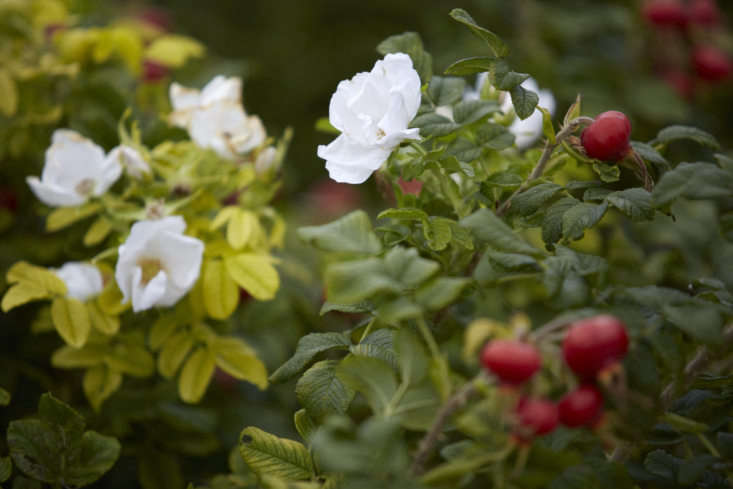Rugosa Rose, Rosa rugosa: “Wrinkled Rose”
As weeds go, the Rugosa rose is even-handed, giving as much as it takes. Considered invasive on the shores of New England, its long period of wildlife-friendly, well-scented flowering is finished with spectacular rose hips.
Swedish botanist Carl Peter Thunberg first introduced the western world to Rosa rugosa (meaning “wrinkled rose” because of its creased petals and serrated foliage) in the 1770s, having come across it in Japan. So, although it is a dominant species in certain areas of the northeast and northwest of the United States, it is not native. It is, on the whole, a much-loved invader with a host of benefits.
Photography by Britt Willoughby Dyer, for Gardenista.

Rose hips are as good as they look, fortified with more vitamin C than citrus. Rose hips make a powerful, immunity-bolstering syrup or vinegar, once the irritating, minute hairs have been strained from the edible part of the fruit (animals do not have this problem). Seed is dispersed by birds and rodents and even by water; the hips are buoyant.

As a wind- and salt-resistant shrub, its ease in tough conditions is illustrated by a thuggish attitude on sand dunes and waterfront properties.

Colonizing exposed areas and thriving in salty air, rugosas are useful as roadside plants, shrugging off the kind of winter salting that spells doom to vintage cars. By the water, their suckering habit stabilizes sand dunes, cliff edges, and riverbanks, preventing erosion. Densely prickled stems aid the formation of thickets; they are more friendly to wildlife than people and are thus useful as impenetrable yet decorative barriers. They are a barbed-wire alternative, with the advantage of a reliably healthy appearance.

Still not convinced? Many varieties of Rosa rugosa have been given the Royal Horticultural Society’s Medal of Garden Merit, and these are the ones to go for in a garden situation. Some of the named varieties have semi-double to fully double flowers, the most popular magenta being highly scented, double Rosa ‘Roseraie de la Haye’. Bred by the same French family (Cochet) in the mid-19th century, semi-double white Rosa ‘Blanche Double de Couvert’, is equally elegant, although its rose hip production is slim. Rosa ‘Fru Dagmar Hustrop’ is more compact, with pale pink, single flowers (and all the hips). It was developed in Denmark in 1874; the beaches of Denmark are another favorite haunt of rugosa roses.

Cheat Sheet
• Long flowering, rose hip forming, thicket developing: disease-resistant Rosa rugosa is full of vitality and can be grown in a wild garden or as an impenetrable barrier.
• Rugosas hybridized with garden roses have produced tamer varieties with subtle or brightly colored flowers (the wild versions being either white or magenta).
• They flower from June, finally retiring after winter has properly settled in.

Keep It Alive
• Rugosas thrive in windy, salty air, their leathery leaves conserving water.
• Unfussy about type of soil or situation, they fall into the popular category of “low maintenance.” Ideally, full or partial sun with well-drained soil is preferred.
• Because they form shapely, buoyant thickets rugosas are useful, suggests Christopher Lloyd in The Well-Tempered Gardener, for creating a framework for more roses, the kind that are more noted for their color than shape.

Read more growing tips in Roses: A Field Guide to Planting, Care & Design in our curated guides to Perennials 101. For more flowering shrubs, see our guides to Shrubs 101. See more:
- Everything You Need to Know About Roses
- Rosa Rugosa: A Field Guide to Planting, Care & Design
- Landscaping Ideas: A Classic Cottage Garden on Cape Cod
- 10 Easy Pieces: Perennials for the Seaside Garden








Have a Question or Comment About This Post?
Join the conversation